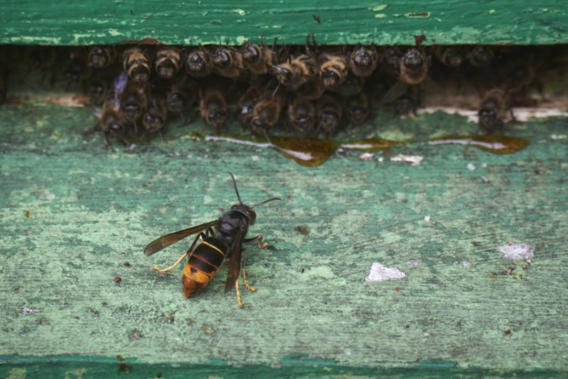Anyone who has never seen an Asian hornet will have the opportunity to do so this summer. An unprecedented increase in the invasive exotic species is expected this summer. The wasp, which is 2 to 3 centimeters in size, inspires fear not only because of its size, but also because an entire nest can easily consume ten thousand honey bees.
The beast was not sighted in Europe until 2004, but one unfortunate introduction in France heralded the start of a European conquest. “The first nest in Flanders was discovered in 2017,” says Tim Adriaens, researcher at the Institute for Nature and Forest Research (Inbo). “We were really on top of it at the time. We were able to keep up with the control until 2022. But last year it really exploded.”
From fewer than 1,500 summer nests in 2022, it went to 6,500 last year. And that exponential increase will continue this year, according to the first figures. In 2024, 305 embryo nests were already found, more than three times more than in the same period last year. These incipient nests, the size of a ping-pong ball, are made by the queen alone. Workers make it a primary nest from June onwards. In August the colony usually moves to a summer nest in the top of a tree.
“If it becomes a normal nesting year, we will easily exceed 30,000 summer nests this year,” says Adriaens. “My estimates range from 16,000 to 40,000 nests.” This means that the fighters will no longer be able to follow at all. “Even if the money were there, you would no longer be able to achieve it operationally. We will have to learn to live with it.”
To reduce the number of Asian hornets, you would have to successfully combat 90 to 95 percent of the summer nests, says Theo Zeegers, entomologist at the Dutch EIS Insect Knowledge Center. “In Flanders and the Netherlands we now reach about 50 percent, although it is difficult to know how many nests you will not find. From 50 to 90 percent requires a huge investment. It also failed in France, Northern Italy and Spain. Why would you think that it would work in Flanders and the Netherlands?”
In a recently published opinion, Zeegers and his colleague Rick Buesink take a clear position: the massive eradication of nests is “wasted money”. This is remarkable because the Asian hornet is on the European Union list. This stipulates that countries must eradicate an incipient population and manage an existing population. Although countries can also opt for ‘zero management’ at that final stage, as Zeegers proposes.
René De Backer, chairman of the Flemish Bee Institute, does not agree with this at all. He sees a decline in the number of beekeepers and links this to the rise of the exotic species. “That is why we must continue to fight them, even if it is utopian to think that we will get rid of them. But it must remain manageable.”
The Asian hornet can endanger an entire colony of bees, Adriaens confirms. “They go hunting for the beehives. The bees get scared and don’t come outside anymore. The colony falls silent. This weakening can lead to higher mortality in winter.” Since the hornet will no longer disappear, beekeepers should invest in hive protection, says Adriaens.
Zeegers is not yet convinced. “In all the scientific literature, I have not been able to find that bee hives are really destroyed by the hornet.” A nest of hornets eats an average of about 9,000 honey bees, he concludes from the literature. “But a beehive contains an average of 40,000 bees, of which an average of 20,000 die in the winter anyway.”
According to the beekeepers, it is not just about the health of the bee, but also that of humans. “The hornet is particularly aggressive in the vicinity of its nest. Last year there were five incidents in Flanders. A crane operator received 20 stitches. Fortunately, he made it,” says De Backer.
“Individual animals do not actively seek out people,” says Adriaens. “But if you disturb a nest, it doesn’t belong to the cat.” The hornet has no more venom than a common lemonade wasp, but multiple stings can be life-threatening.
“That is correct,” says Zeegers, “but it is no different for the European hornet. It builds its primary nests in exactly the same places. That was never made a problem. The beekeepers use all arguments. That’s cherry picking. That’s not how you do science. It is a invented problem.”
The hornet is also not the only one that eats honey bees, Zeegers notes. The beewolf also does this, to approximately the same extent. “Beekeepers are not concerned about that at all. It’s pure emotion. As a beekeeper, I would be more concerned about pesticide use.”
Pesticides are also used en masse in Flanders to remove hornet nests. This affects, among other things, the birds that eat the larvae. “That’s a real shame. In the Netherlands we remove the nests without poison, with a large vacuum cleaner. That is cheaper too,” says Zeegers.
Every year times five
Shouldn’t we also continue to contain the exotic species to protect our biodiversity? “We don’t have enough insight into that,” says Adriaens. “The hornet is very opportunistic and mainly eats native species that are commonly present, such as bees, blowflies and house flies.”
To avoid feeding on rare species, Flanders primarily concentrates control around vulnerable areas such as heath, salt marshes and mudflats and willow tidal forests. “We already have so little of that, and we want to protect that very valuable fauna and flora,” says Adriaens.
Estimates from France show that the population is increasing fivefold every year. That is also the estimate for Flanders, in the Netherlands it is multiplied by seven every year. But when will it stop? No one knows that for now. “We are certainly still in the phase of unchecked exponential growth in the Netherlands,” says Zeegers. “But at some point saturation will come, because there is not enough food or there is no more place to build nests.” The ecosystem will also adapt, and the hornet itself will fall prey to, for example, honey buzzards and fungi.
That saturation point is not yet in sight for us either, Adriaens fears. He dares to make a prediction. “The hornet is becoming the most visible insect in Flanders. It is big, there are a lot of them and they fly during the day,” says Adriaens.
And also: the Flemish pay a lot of attention to it. “In the beginning, 90 percent of the reports were incorrect, and newspapers invariably printed a photo of the Japanese giant hornet. Now everyone knows the Asian hornet, and 90 percent of the reports are correct. That is the success of citizen science. Hopefully the next step is that the panic also decreases.”


